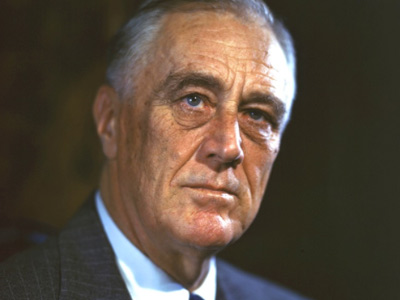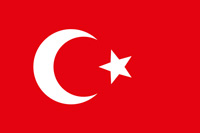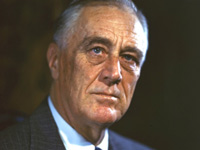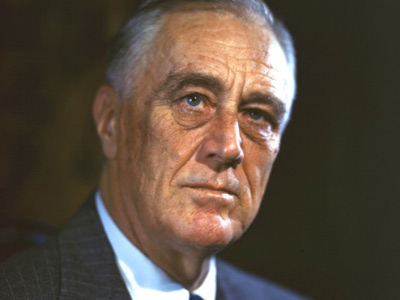Franklin Delano Roosevelt (1882-1945)

Early Political Career
State Senator and Tammany antagonist
Roosevelt held little passion for the practice of law, and confided to friends that he planned to eventually enter politics. Prior to the 1910 elections, the local Democratic Party recruited Roosevelt to run for a seat in the New York State Assembly. Roosevelt's campaign for the state assembly ended after the Democratic incumbent, Lewis Stuyvesant Chanler, chose to seek re-election. Rather than putting his political hopes on hold, Roosevelt ran for a seat in the state senate. The senate district, located in Dutchess County, Columbia County, and Putnam County, was strongly Republican, having elected one Democrat since 1856. The local party chose Roosevelt because his Republican cousin Theodore was still one of the country's most prominent politicians, and a Democratic Roosevelt was good publicity; the candidate could also pay for his own campaign. Roosevelt, who acted as his own campaign manager, traveled throughout the district via automobile at a time when many could not afford cars. Due to his aggressive and effective campaign, the Roosevelt name's influence in the Hudson Valley, and the Democratic landslide that year, Roosevelt won the election, surprising almost everyone. Though legislative sessions rarely lasted more than ten weeks, Roosevelt treated his new position as a full-time career.
Taking his seat on January 1, 1911, Roosevelt immediately became the leader of a group of "Insurgents" who opposed the bossism of the Tammany Hall machine that dominated the state Democratic Party. In the 1911 U.S. Senate election, which was determined in a joint session of the New York state legislature, Roosevelt opposed the Tammany candidate, William F. Sheehan. On March 31, after a prolonged deadlock, compromise candidate James A. O'Gorman was elected, giving Roosevelt national exposure and some experience in political tactics and intrigue. One Tammany leader warned that Roosevelt should be eliminated immediately, before he disrupted Democrats as much as his cousin disrupted the Republicans. Roosevelt soon became a popular figure among New York Democrats, though he had not yet become an eloquent speaker. News articles and cartoons began depicting "the second coming of a Roosevelt" that sent "cold shivers down the spine of Tammany".
Roosevelt, again in opposition to Tammany Hall, supported New Jersey Governor Woodrow Wilson's successful bid for the 1912 Democratic nomination, earning an informal designation as an original Wilson man. Despite Theodore Roosevelt's third party campaign for the presidency, Franklin Roosevelt continued to support Wilson in the general election, and Wilson became the first Democrat to win a presidential election since 1892. Overcoming a bout with typhoid fever, and due to the help of journalist Louis McHenry Howe, Roosevelt was re-elected in the 1912 elections. After the elections, he served as chairman of the Agriculture Committee, and his success with farm and labor bills was a precursor to his New Deal policies twenty years later. By this time he had become more consistently progressive, in support of labor and social welfare programs for women and children; cousin Theodore was of some influence on these issues.
Assistant Secretary of the Navy
Roosevelt's support of Wilson led to his appointment in March 1913 as Assistant Secretary of the Navy, the second-ranking official in the Navy Department after Secretary Josephus Daniels. Roosevelt had a lifelong affection for the Navy—he had already collected almost 10,000 naval books and claimed to have read all but one—and was more ardent than his boss Daniels in supporting a large and efficient naval force. With Wilson's support, Daniels and Roosevelt instituted a merit-based promotion system and made other reforms to extend civilian control over the autonomous departments of the Navy. Roosevelt oversaw the Navy's civilian employees and earned the respect of union leaders for his fairness in resolving disputes. Not a single strike occurred during his seven-plus years in the office, during which Roosevelt gained experience in labor issues, government management during wartime, naval issues, and logistics, all valuable areas for future office.
In 1914, Roosevelt made an ill-conceived decision to run for the seat of retiring Republican Senator Elihu Root of New York. Though Roosevelt won the backing of Treasury Secretary William Gibbs McAdoo and Governor Martin H. Glynn, he faced a formidable opponent in the Tammany-backed James W. Gerard. He also lacked Wilson's backing, as Wilson needed Tammany's forces to help marshal his legislation and secure his 1916 re-election. Roosevelt was soundly defeated in the Democratic primary by Gerard, who in turn lost the general election to Republican James Wolcott Wadsworth Jr. Roosevelt learned a valuable lesson, that federal patronage alone, without White House support, could not defeat a strong local organization. After the election, Roosevelt and the boss of the Tammany Hall machine, Charles Francis Murphy, sought an accommodation with one another and became political allies.
Following his defeat in the Senate primary, Roosevelt refocused on the Navy Department. World War I broke out in July 1914, with the Central Powers of Germany The German Empire, also referred to as Imperial Germany, the Second Reich, as well as simply Germany, was the period of the German Reich from the unification of Germany in 1871 until the November Revolution in 1918, when the German Reich changed its form of government from a monarchy to a republic. During its 47 years of existence, the German Empire became the industrial, technological, and scientific giant of Europe. , Austria-Hungary
The German Empire, also referred to as Imperial Germany, the Second Reich, as well as simply Germany, was the period of the German Reich from the unification of Germany in 1871 until the November Revolution in 1918, when the German Reich changed its form of government from a monarchy to a republic. During its 47 years of existence, the German Empire became the industrial, technological, and scientific giant of Europe. , Austria-Hungary Austria-Hungary, often referred to as the Austro-Hungarian Empire, the Dual Monarchy, or Austria, was a constitutional monarchy and great power in Central Europe between 1867 and 1918. Austria-Hungary was one of the Central Powers in World War I, which began with an Austro-Hungarian war declaration on the Kingdom of Serbia on 28 July 1914., and Ottoman Empire
Austria-Hungary, often referred to as the Austro-Hungarian Empire, the Dual Monarchy, or Austria, was a constitutional monarchy and great power in Central Europe between 1867 and 1918. Austria-Hungary was one of the Central Powers in World War I, which began with an Austro-Hungarian war declaration on the Kingdom of Serbia on 28 July 1914., and Ottoman Empire The Ottoman Empire, also known as the Turkish Empire, was an empire that controlled much of Southeast Europe, Western Asia, and Northern Africa between the 14th and early 20th centuries. The Ottomans ended the Byzantine Empire with the conquest of Constantinople in 1453. The Ottoman Empire's defeat and the occupation of part of its territory by the Allied Powers in the aftermath of World War I resulted in its partitioning and the loss of its Middle Eastern territories. seeking to defeat the Allied Powers of Britain, France, and Russia. The Wilson administration initiated an expansion of the Navy after the sinking of the RMS Lusitania by a German submarine, and Roosevelt helped establish the United States Navy Reserve and the Council of National Defense. In March 1917, after Germany initiated its unrestricted submarine warfare campaign, Roosevelt asked Wilson for permission to fit the naval fleet out for war; the request was denied. After the U.S. entrance into World War I in April 1917, he very much wanted to get into a military uniform, but the armistice took shape before this could materialize. The Navy expanded fourfold in the first six months of the war, and Roosevelt oversaw procurement and construction.
The Ottoman Empire, also known as the Turkish Empire, was an empire that controlled much of Southeast Europe, Western Asia, and Northern Africa between the 14th and early 20th centuries. The Ottomans ended the Byzantine Empire with the conquest of Constantinople in 1453. The Ottoman Empire's defeat and the occupation of part of its territory by the Allied Powers in the aftermath of World War I resulted in its partitioning and the loss of its Middle Eastern territories. seeking to defeat the Allied Powers of Britain, France, and Russia. The Wilson administration initiated an expansion of the Navy after the sinking of the RMS Lusitania by a German submarine, and Roosevelt helped establish the United States Navy Reserve and the Council of National Defense. In March 1917, after Germany initiated its unrestricted submarine warfare campaign, Roosevelt asked Wilson for permission to fit the naval fleet out for war; the request was denied. After the U.S. entrance into World War I in April 1917, he very much wanted to get into a military uniform, but the armistice took shape before this could materialize. The Navy expanded fourfold in the first six months of the war, and Roosevelt oversaw procurement and construction.
With the end of World War I World War I, also known as the First World War, or the Great War, was a global war originating in Europe that lasted from 28 July 1914 to 11 November 1918. More than 70 million military personnel, including 60 million Europeans, were mobilized in one of the largest wars in history. The war drew in all the world's economic great powers, assembled in two opposing alliances: the Allies versus the Central Powers of Germany and Austria-Hungary. View World War I » in November 1918, Daniels and Roosevelt oversaw the demobilization of the Navy. Against the advice of older officers such as Admiral William Benson—who claimed he could not "conceive of any use the fleet will ever have for aviation"—Roosevelt personally ordered the preservation of the Navy's Aviation Division. With the Wilson administration coming to an end, Roosevelt began planning for his next run for office. Roosevelt and his associates approached Herbert Hoover about running for the 1920 Democratic presidential nomination, with Roosevelt as his running mate.
World War I, also known as the First World War, or the Great War, was a global war originating in Europe that lasted from 28 July 1914 to 11 November 1918. More than 70 million military personnel, including 60 million Europeans, were mobilized in one of the largest wars in history. The war drew in all the world's economic great powers, assembled in two opposing alliances: the Allies versus the Central Powers of Germany and Austria-Hungary. View World War I » in November 1918, Daniels and Roosevelt oversaw the demobilization of the Navy. Against the advice of older officers such as Admiral William Benson—who claimed he could not "conceive of any use the fleet will ever have for aviation"—Roosevelt personally ordered the preservation of the Navy's Aviation Division. With the Wilson administration coming to an end, Roosevelt began planning for his next run for office. Roosevelt and his associates approached Herbert Hoover about running for the 1920 Democratic presidential nomination, with Roosevelt as his running mate.
Campaign for Vice President
Roosevelt's plan to convince Hoover to run for the Democratic nomination fell through after Hoover publicly declared himself to be a Republican, but Roosevelt nonetheless decided to seek the 1920 vice presidential nomination. After Governor James M. Cox of Ohio won the party's presidential nomination, he chose Roosevelt as his running mate, and the party formally nominated Roosevelt by acclamation. Although his nomination surprised most people, Roosevelt was considered as bringing balance to the ticket as a moderate, a Wilsonian, and a prohibitionist with a famous name. Roosevelt had just turned 38, four years younger than Theodore had been when he received the same nomination from his party. Roosevelt resigned as Assistant Secretary of the Navy after the Democratic convention and campaigned across the nation for the Cox–Roosevelt ticket.
During the campaign, Cox and Roosevelt defended the Wilson administration and the League of Nations, both of which were unpopular in 1920. Roosevelt personally supported U.S. membership in the League of Nations, but, unlike Wilson, he favored compromising with Senator Henry Cabot Lodge and other "Reservationists." The Cox–Roosevelt ticket was defeated by Republicans Warren G. Harding and Calvin Coolidge in the presidential election by a wide margin, and the Republican ticket carried every state outside of the South. Roosevelt accepted the loss without issue and later reflected that the relationships and good will that he built in the 1920 campaign proved to be a major asset in his 1932 campaign. The 1920 election also saw the first public participation of Eleanor Roosevelt who, with the support of Louis Howe, established herself as a valuable political ally. After the election, Roosevelt returned to New York City, where he practiced law and became a vice president of the Fidelity and Deposit Company.
HISTORY

RESOURCES
This article uses material from the Wikipedia article "Franklin Delano Roosevelt (1882-1945)", which is released under the Creative Commons Attribution-Share-Alike License 3.0.
© Stories Preschool. All Rights Reserved.









